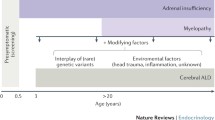Abstract
The childhood form of adrenoleukodystrophy is an X-linked recessive disorder which is characterized biochemically by elevated concentrations of saturated very long chain fatty acids in tissues and plasma and impaired very long chain fatty acid oxidation in fibroblasts and leukocytes from adrenoleukodystrophy patients. The most consistently observed increase is that in hexacosanoic acid (C26:0); thus, measurement of plasma C26:0 concentration by gas-liquid chromatography provides a rapid, sensitive method of diagnosis. Prenatal diagnosis of adrenoleukodystrophy can be made by measurement of C26:0 concentrations in amniocytes and chorionic villus cells. Heterozygote (carrier) detection has also been accomplished by biochemical measurement of C26:0 in plasma and skin fibroblasts. In a study of over 200 obligate heterozygotes, >90% showed abnormal concentrations of C26:0. Hybridization studies using the cloned DNA fragment St14 detects polymorphisms in the distal end of the long arm of the X chromosome (Xq27–28) and six informative kindreds have shown co-segregation of adrenoleukodystrophy and the St14 marker through 65 meioses. Thus, such studies can supplement very long chain fatty acid concentrations in heterozygote detection. Therapeutic interventions for adrenoleukodystrophy, such as dietary restriction of very long chain fatty acids, administration of clofibrate or carnitine, immunosuppression and adrenal hormone replacement, have not been successful. Recently, a modification of the very long chain fatty acid-restricted diet has been employed in which this diet is supplemented with synthetic glycerol trioleate. The rationale for this diet is that decreased very long chain fatty acid synthesis by fibroblasts from patients with adrenoleukodystrophy was observed when oleic acid was added to the culture medium. In a study of 14 patients on this diet from 2 to 11 months, there was a mean reduction in plasma C26:0 levels of 46%, with one patient achieving a normal plasma level. The effect of lowering plasma very long chain fatty acid concentrations on the neurologic status of patients with adrenoleukodystrophy and on the development of symptoms in asymptomatic individuals with elevated very long chain fatty acid concentrations remains to be established.
Similar content being viewed by others
References
Aubourg, P. R., Sack, G. H. Jr., Meyers, D. A., Lease, J. J. and Moser, H. W. Linkage of adrenoleukodystrophy to a polymorphic DNA probe.Ann. Neurol. (1986) in press
Griffin, D. E., Moser, H. W., Mendoza, Q., Moench, T. R., O'Toole, S., and Moser, A. B. Identification of the inflammatory cells in the central nervous system of patients with adrenoleukodystrophy.Ann. Neurol. 18 (1985) 660–664
Igarashi, M., Schaumburg, H. H., Powers, J. M., Kishimoto, Y., Kolodny, E. and Suzuki, K. Fatty acid abnormality in adrenoleukodystrophy.J. Neurochem. 26 (1976) 851–860
Kelley, R. I., Datta, N. S., Dobyns, W. B., Hajra, A. K., Moser, A. E., Noetzel, M. J., Zackai, E. M. and Moser, H. W. Neonatal adrenoleukodystrophy: New cases, biochemical studies, and differentiation from Zellweger and related peroxisomal polydystrophy syndromes.Am. J. Med. Genet. 23 (1986) 869–901
Migeon, B. R., Moser, H. W., Moser, A. B., Axelman, J., Sillence, D. and Norum, R. A. Adrenoleukodystrophy: Evidence for X-linkage, inactivation, and selection favoring the mutant allele in heterozygous cells.Proc. Natl. Acad. Sci. USA 78 (1981) 5066–5070
Moser, H. W., Moser, A. B., Kawamura, N., Murphy, J., Suzuki, K., Schaumburg, H. H., Kishimoto, Y. and Milunsky, A. Adrenoleukodystrophy: Elevated C26 fatty acid in cultured skin fibroblasts.Ann. Neurol. 7 (1980) 542–549
Moser, H. W., Moser, A. B., Frayer, K. K., Chen, W., Schulman, J. D., O'Neill, B. P. and Kishimoto, Y. Adrenoleukodystrophy: Increased plasma content of saturated very long chain fatty acids.Neurology 31 (1981) 1241–1249
Moser, H. W., Moser, A. E., Trojak, J. E. and Supplee, S. W. Identification of female carriers of adrenoleukodystrophy.J. Pediatr. 103 (1983) 54–59
Moser, H. W., Moser, A. E., Singh, I. and O'Neill, B. P. Adrenoleukodystrophy: Survey of 303 cases: Biochemistry, diagnosis, and therapy.Ann. Neurol. 16 (1984a) 628–641
Moser, A. E., Singh, I., Brown, F. R. III, Solish, G. I., Kelley, R. I., Benke, P. J. and Moser, H. W. The cerebrohepatorenal (Zellweger) syndrome: Increased levels and impaired degradation of very long chain fatty acids and their use in prenatal diagnosis.N. Engl. J. Med. 310 (1984b) 1141–1146
Moser, H. W., Tutschka, P. J., Brown, F. R. III, Moser, A. E., Yeager, A. M., Singh, I., Mark, S. A., Kumar, A. A. J., McDonald, J. M., White, C. R. III, Maumenee, I. H., Green, W. R., Powers, J. M. and Santos, G. W. Bone marrow transplant in adrenoleukodystrophy.Neurology 34 (1984c) 1410–1417
Moser, H. W. Peroxisomal disorders.J. Pediatr. 108 (1986a) 89–91
Moser, H. W., Naidu, S., Kumar, A. J. and Rosenbaum, A. E. The adrenoleukodystrophies.Crit. Rev. Neurobiol. (1986b) in press
Moser, A. B., Borel, J., Odone, A., Naidu, S., Cornblath, D., Sanders, D. B. and Moser, H. W. A new dietary therapy for adrenoleukodystrophy: Biochemical and preliminary clinical results in 36 patients.Ann. Neurol. 21 (1987) 240–249
Refsum, S. Heredopathia atactica polyneuritiformis: Phytanic acid storage disease, Refsum disease: A biochemically well-defined disease with a specific dietary treatment.Arch. Neurol. 38 (1981) 605–606
Rizzo, W. B., Watkins, P. A., Phillips, M. W., Cranin, D., Campbell, B. and Avigan, J. Adrenoleukodystrophy: Oleic acid lowers fibroblast C22–26 fatty acids.Neurology 36 (1986) 357–361
Singh, I., Moser, A. E., Moser, H. W. and Kishimoto, Y. Adrenoleukodystrophy: Impaired oxidation of very long chain fatty acids in white blood cells, cultured skin fibroblasts, and amniocytes.Pediatr. Res. 18 (1984a) 286–290
Singh, I., Moser, A. E., Goldfischer, S. and Moser, H. W. Lignoceric acid is oxidized in the peroxisome: Implications for the Zellweger cerebro-hepato-renal syndrome and adrenoleukodystrophy.Proc. Natl. Acad. Sci. USA 81 (1984b) 4203–4207
Van Duyn, M. A., Moser, A. B., Brown, F. R. III, Sacktor, N., Liu, A. and Moser, H. W. The design of a diet restricted in saturated very long chain fatty acids: Therapeutic application in adrenoleukodystrophy.Am. J. Clin. Nutr. 40 (1984) 277–282
Author information
Authors and Affiliations
Rights and permissions
About this article
Cite this article
Watkins, P.A., Naidu, S. & Moser, H.W. Adrenoleukodystrophy: Biochemical procedures in diagnosis, prevention and treatment. J Inherit Metab Dis 10 (Suppl 1), 46–53 (1987). https://doi.org/10.1007/BF01812846
Issue Date:
DOI: https://doi.org/10.1007/BF01812846




